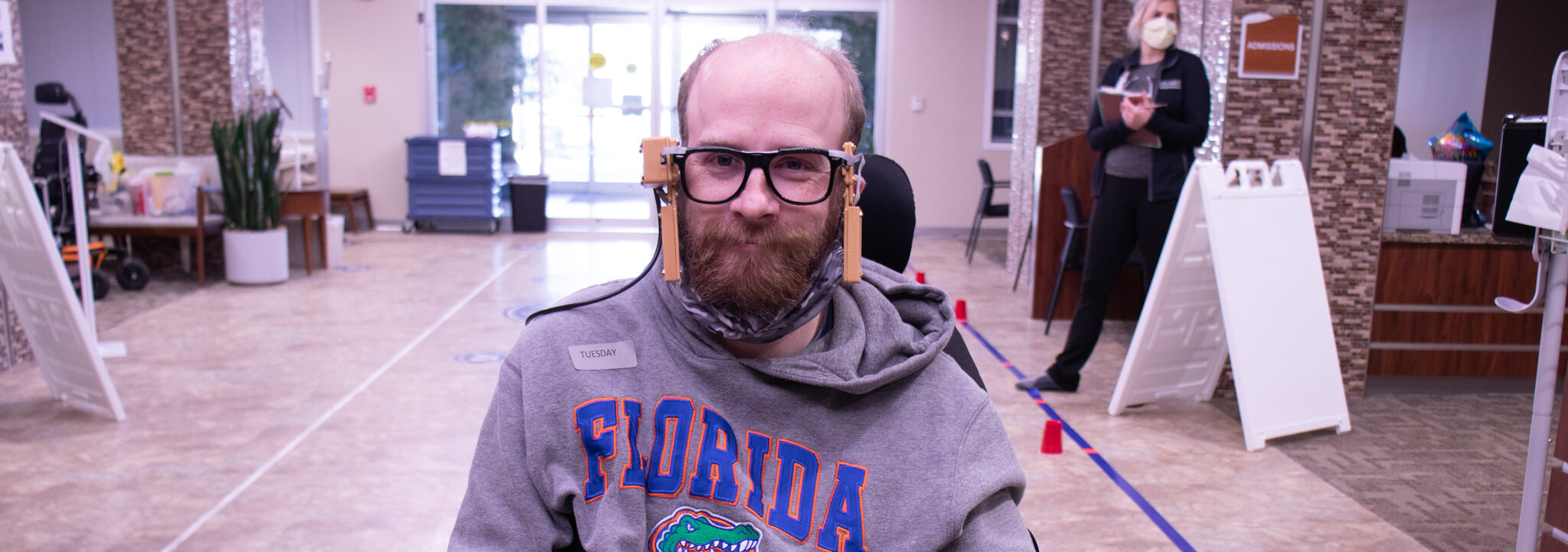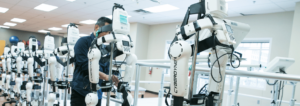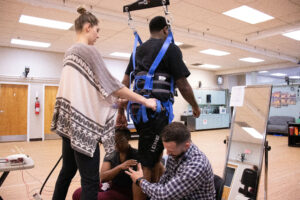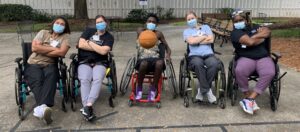MagTrack Technology Opens Doors for Independent Operation of Smartphones, Computers, other Devices for Wheelchair Users

Back to physical health resource hub
Georgia Tech School of Electrical and Computer Engineering Partners with Brooks Rehabilitation in Human Participant Phase of Groundbreaking Technology Study
FOR IMMEDIATE RELEASE
Jacksonville FL, February 8, 2022 – Brooks Rehabilitation is pleased to announce the MagTrack study, a collaborative research endeavor between Brooks and the Georgia Tech School of Electrical and Computer Engineering has been successfully completed. Feedback from the Brooks’ clinical team and its patients has allowed the engineering team at Georgia Tech to transform their early research prototype into a user-ready version that was tested by more than 17 power wheelchair users living with tetraplegia – a form of paralysis, caused by spinal cord injury, which affects the arms, hands, trunk, legs, and pelvic organs.
The collaboration between the Brooks and Georgia Tech teams has created a path to a first-of-its-kind, innovative application for patients and individuals living with disabilities. The teams- comprised of physicians, clinical therapists, and engineers- have a multi-disciplinary level of expertise of advanced science, technology, and clinical rehabilitation.
“We met with the Georgia Tech team years ago, when we first heard of the research breakthroughs they were achieving for wheelchair users. Brooks is constantly looking for technology that is useful for our patient population living with spinal cord injuries and mobility impairments. To see where the MagTrack project has advanced even just since the early stages of this study is incredible,” said Geneva Tonuzi, MD Medical Director, Spinal Cord Injury Program & Spinal Cord Injury / Disorders Day Treatment Program, Medical Director, Cyberdyne HAL Therapy, Brooks Rehabilitation.
As a result of this engineering-clinical collaboration, MagTrack was created as a cutting-edge assistive technology that enables power wheelchair users to control their connected devices (e.g., smartphone, computer) and drive their power wheelchair using an alternative, multi-modal controller. In addition, the assistive device is designed to be wearable, wireless, and adaptable to the user’s specific condition.
The MagTrack study is earning the praise of patients and scientists alike and has been published in IEEE Transactions on Biomedical Engineering. Since its inception, the MagTrack studies have tested the performance of the Head-Tongue Controller (HTC), an earlier version of the MagTrack technology, on its ability to perform complex human-machine interactions that will enhance the users’ quality of life. The MagTrack’s HTC allows the user to perform a variety of complex tasks in a single controller
through the use of tongue and head movements, which are detected by a discrete eyewear and a tracer placed on the tongue. This combination of input modalities allows the user to perform a variety of daily functions with customizable control; from performing complex computer tasks (e.g., mouse navigation, scrolling, drag-and-drop), to completing advanced driving maneuvers when connected to a power wheelchair.
In the latest study, researchers connected the MagTrack technology to a single power wheelchair donated by Quantum Rehab, and recruited 17 patient volunteers from Brooks Rehabilitation to test the functionality and usability of the device by completing a set of both simple and advanced driving tasks. Results showed that new users of MagTrack can complete these tasks as fast, and sometimes even faster, with the MagTrack’s HTC rather than their personal, alternative controller. Since the study session only lasted less than 3 hours – and in a power wheelchair that wasn’t their own – it is anticipated that participants would be much more proficient, and thus perform better with MagTrack if they are given more time to familiarize themselves with its multimodal capabilities, and use their own power wheelchair.
“Working with all of the participants has been very rewarding. Each patient who came in was someone who has been directly impacted by a spinal cord injury and who can truly benefit from this technology. It was amazing to see how their faces lit up when they saw they were able to control their wheelchair with such ease and comfort. The feedback from participants was great! They all said how impactful the technology is and how they can see this impacting their day-to-day lives if it were available to them. It’s been such an honor to be a part of this process and see the work and thought process behind such advanced technology,” said Jesse Milliken (Baldwin), M.S. CCC-SLP, Spinal Cord Injury Program, Brooks Rehabilitation Hospital.
Patients from the Brooks Spinal Cord Injury Program that have participated in phase three of the study call the advancement ‘exciting’ and a ‘great system that can be used for so many things.’ After experiencing the technology themselves, they feel it will ‘really touch the lives of those that are able to use it.’
To date, the head array and sip-and-puff are the most common alternative controllers recommended by physical therapists to individuals living with tetraplegia, while specialized switches and joystick technology are available for those with remaining mobility in their upper extremities. These technologies were developed many decades ago for the basic need of controlling a power wheelchair. Since then, a lack of innovation in this field has hindered these assistive technologies from adapting to today’s technology. Furthermore, they are affixed to the wheelchair which becomes inaccessible once the user is transferred to a bed, a couch, or any location away from the wheelchair. Therefore, there is a growing need for this population to have access to new alternative controllers that will enable them to be active members of this interconnected digital world.
“The trajectory of the MagTrack study shows a previously unprecedented possibility for the advancement of independent function as well as mobility for electric wheelchair users. Our team and partners are energized and motivated by the recent patient trials to continue to push this technology and its capabilities as far as possible. This technology can significantly improve people’s lives. We will continue to work to see these advances in assistive technology come to life,” said Dr. Omer T. Inan, Ph.D., a faculty member at Georgia Tech, Director of the Inan Research Lab and Linda
J. and Mark C. Smith Chair in Bioscience and Bioengineering. Inan is an Associate Professor in the School of Electrical and Computer Engineering and an Adjunct Associate Professor in the Wallace H. Coulter Department of Biomedical Engineering.
Results from these studies are being used to further refine MagTrack and help design future studies to evaluate a participant’s ability to use this new type of alternative control in clinical, home, and community environments.
Special thanks and recognition goes to all team members involved in this groundbreaking study including but not limited to:
- Dr. Nordine Sebkhi, Ph.D., Postdoctoral Researcher, Inan Research Lab, School of Electrical & Computer Engineering, Georgia Tech
- Arpan Bhavsar, M.S., Research Engineer, Inan Research Lab, School of Electrical & Computer Engineering, Georgia Tech
- Dr. Nazmus Sahadat, Ph.D., Applied Scientist, Amazon
- Dr. David V. Anderson, Ph.D., Professor, School of Electrical & Computer Engineering, Georgia Tech
- Dr. Omer T. Inan, Ph.D., Linda J. and Mark C. Smith Chair in Bioscience and Bioengineering, Associate Professor, School of Electrical & Computer Engineering, Adjunct Associate Professor of Biomedical Engineering, Director of the Inan Research Lab
- Dr. Geneva Tonuzi, MD, Medical Director, Spinal Cord Injury Program & Spinal Cord Injury / Disorders Day Treatment Program, Medical Director, Brooks Cyberdyne HAL Therapy
- Erica Walling MPT, ATP/SMS, Wheelchair Clinic Manager, Brooks Rehabilitation
- Jesse Milliken, MS, CCC-SLP, Speech-Language Pathologist, Spinal Cord Injury Program, Brooks Rehabilitation
- Dr. Raine Osborne, PT, DPT, EdD, FAAOMPT, Director of Research, Brooks Rehabilitation
About Brooks Rehabilitation
For more than 50 years, Brooks Rehabilitation, headquartered in Jacksonville, Fla., has been a comprehensive source for physical rehabilitation services. As a nonprofit organization, Brooks operates one of the nation’s largest inpatient rehabilitation hospitals in the U.S. with 160 beds, one of the region’s largest home healthcare agencies, more than 40 outpatient therapy clinics, a Center for Inpatient Rehabilitation in partnership with Halifax Health in Daytona Beach, the Brooks Rehabilitation Medical Group, two skilled nursing facilities, assisted living and memory care. Brooks
will treat more than 60,000 patients through its system of care each year. In addition, Brooks operates the Clinical Research Center, which specializes in research for stroke, brain injury, spinal cord injury, and more to advance the science of rehabilitation. Brooks also provides many low or no-cost community programs and services such as the Brooks Clubhouse, Brooks Aphasia Center, and Brooks Adaptive Sports and Recreation to improve the quality of life for people living with physical disabilities. For more information, visit brooksrehab.org. Connect with us via Youtube, Facebook, and Twitter.
About Georgia Tech
The Georgia Institute of Technology, or Georgia Tech, is a top 10 public research university developing leaders who advance technology and improve the human condition. The Institute offers business, computing, design, engineering, liberal arts, and sciences degrees. Its nearly 40,000 students representing 50 states and 149 countries, study at the main campus in Atlanta, at campuses in France and China, and through distance and online learning. As a leading technological university, Georgia Tech is an engine of economic development for Georgia, the Southeast, and the nation, conducting more than $1 billion in research annually for government, industry, and society.
About the School of Electrical and Computer Engineering
The School of Electrical and Computer Engineering (ECE) is one of eight schools and departments in the College of Engineering at the Georgia Institute of Technology. All ECE undergraduate and graduate programs are in the top five of the most recent college rankings by U.S. News & World Report. Over 2,500 students are enrolled in the School’s graduate and undergraduate programs, and in the last academic year, 746 degrees were awarded. One hundred ECE faculty members are involved in 11 areas of research, education, and commercialization – bioengineering, computer systems and software, digital signal processing, electrical energy, electromagnetics, electronic design and applications, microsystems, optics and photonics, systems and controls, telecommunications, and VLSI systems and digital design.







